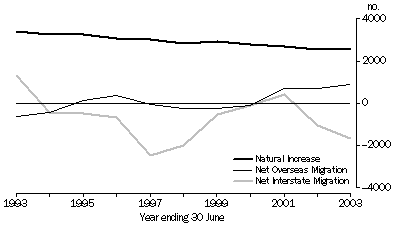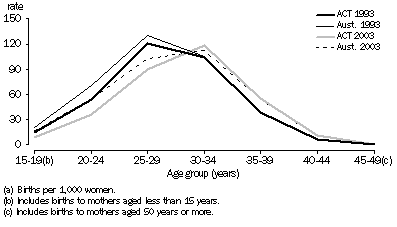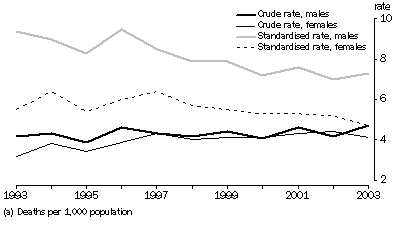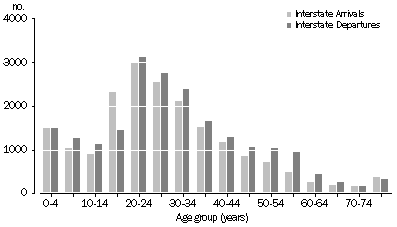POPULATION
BIRTHS AND CONFINEMENTS
DEATHS
MIGRATION
MARRIAGES
DIVORCES
NOTES
OVERVIEW
This electronic product provides a demographic overview of the Australian Capital Territory, 2003. It contains summary tables and commentary on trends in the components of population change including births, deaths and migration. Marriages, divorces, estimated resident population and various demographic rates are also presented. Population and migration data are for the year ended 30 June 2003, while births, deaths, marriages and divorces data are for the year ended 31 December 2003.
For comparisons between the states and territories of Australia, please refer to Demography, Australia, 2003 (cat. no. 3311.0.55.001). Demography publications for each state and territory can be accessed from the following links:
Additional state demographic data are also available from publications and data cubes linked at the foot of this page. The Demography Theme Page provides links to other Australian as well as international demographic statistics. The National Regional Profiles provide economic and social statistics of Statistical Local Areas and Local Government Areas of Australia.
INQUIRIES
For further information about these and related statistics, contact the National Information and Referral Service on 1300 135 070 or Neil Scott on Canberra (02) 6252 5997.
SUMMARY COMMENTARY
POPULATION
At 30 June 2003 the Australian Capital Territory (ACT) resident population was estimated to have reached 323,400 persons (159,700 males and 163,600 females). This represented a population increase of 8.0% over the last decade from 299,300 persons in June 1993. The ACT accounted for 1.6% of the Australian population in 2003.
POPULATION COMPONENTS, Australian Capital Territory - 1993-2003

The annual population growth rate in the ACT in 2003 was 0.6%, which was lower than the national level (1.2%). This growth represented an increase of 1,900 persons, which was composed of natural increase (2,600 persons), net overseas migration (890 persons) and net interstate migration (-1,600 persons). Natural increase was a result of 4,100 births outnumbering 1,400 deaths. This was 2.7% higher than the level of natural increase experienced in 2002 (2,500 persons), and 24.1% lower than in 1993 (3,400 persons).
POPULATION, Australian Capital Territory - Selected years at 30 June |
|
 |  |  | 1993 | 2002 | 2003 |
|
| Estimated resident population | ('000) | 299.3 | 321.5 | 323.4 |
| Components of population change(a) |  |  |  |  |
 | Natural increase(b) | no. | 3,437 | 2,541 | 2,610 |
 | Net overseas migration(c) | no. | -603 | 698 | 885 |
 | Net interstate migration | no. | 1,316 | -1,044 | -1,644 |
| Total increase(d) | no. | 4,628 | 2,195 | 1,851 |
| Annual growth rate | % | 1.57 | 0.69 | 0.58 |
| Estimated resident households(e) | ('000) | 104.8 | (f)nya | (f)nya |
|
| nya not yet available |
| (a) From previous year. |
| (b) Births and deaths figures used to compile natural increase for population estimates are based on year of occurrence and may differ from births and deaths data based on year of registration displayed in the Births and Confinements and Deaths sections of this table. |
| (c) Until 1997 net overseas migration data for Jervis Bay, Christmas Island and Cocos (Keeling) Island were randomly allocated to the states and territories. For these years the sum of the components may therefore not equal net overseas migration. |
| (d) Includes intercensal discrepancy not accounted for by natural increase and net migration. |
| (e) 1993 figures are based on 1996 census, figures from 1997 on are based on 2001 census. |
| (f) Data is under review |
BIRTHS AND CONFINEMENTS
In 2003 there were 4,100 live births registered to mothers usually resident in the ACT. This was an increase of 0.4% from the number of registered births in 2002, and a decrease of 6.5% from the number recorded in 1993 (4,400 births). There were 2,100 male births and 2,000 female births registered in 2003, resulting in a sex ratio of 106.4 males per 100 females.
There were 3,000 nuptial births and 1,100 exnuptial births in the ACT in 2003. Nuptial births showed a decrease of 0.3% from 2002 and a decline of 11.8% from the numbers recorded in 1993 (3,400). Exnuptial births have experienced an 11.6% increase over the last decade, with an increase of 2.4% between 2002 and 2003. Nuptial births accounted for 72.7% of all births in 2003 which was higher than the national average for nuptial births at 68.4%.
The ACT's crude birth rate in 2003 was 12.8 births per 1,000 of the population. The total fertility rate (TFR), that is the number of children a female would bear during her lifetime based on current age-specific fertility rates, increased from 1.59 children per woman in 2002 to 1.60 in 2003. Although this was an increase on 2002 which had ended a trend of long-term decline, it was still below the replacement level (2.1) and was the lowest rate of all states and territories.
BIRTHS AND CONFINEMENTS(a), Australian Capital Territory - Selected years |
|
 |  |  | 1993 | 2002 | 2003 |
|
| Live births |  |  |  |  |
 | Number | no. | 4,414 | 4,112 | 4,128 |
 | Crude birth rate(b) | rate | 14.7 | 12.8 | 12.8 |
 | Total fertility rate(c) | rate | 1.688 | 1.593 | 1.601 |
 | Net reproduction rate(d) | rate | 0.827 | 0.778 | 0.769 |
| All confinements |  |  |  |  |
 | Number | no. | 4,349 | 4,048 | 4,071 |
 | Median age of mother(e) | years | 29.1 | 30.7 | 31.0 |
| Nuptial confinements |  |  |  |  |
 | Number | no. | 3,353 | 2,956 | 2,962 |
 | Median age of mother(e) | years | 29.8 | 31.4 | 31.6 |
 | Median age of father(e) | years | 32.1 | 33.5 | 33.5 |
| First nuptial confinements |  |  |  |  |
 | Number | no. | 1,357 | 1,284 | 1,315 |
 | Median age of mother(e) | years | 28.3 | 30.4 | 30.3 |
|
| (a) Compiled on year of registration basis. |
| (b) Births per 1,000 population. |
| (c) Births per woman. |
| (d) Daughters surviving to reproductive age per woman. |
| (e) The age at which half the population is older and half is younger. |
In the ACT in 2003 the net reproduction rate (the average number of daughters a woman would bear during her reproductive lifetime if she was subject to current female age-specific fertility rates and to prevailing mortality rates) was 0.77, below the replacement level of one.
The ACT continued to experience a trend towards parents having children later in life, with the median age of mothers reaching a high of 31.0 years in 2003, up from 29.1 years in 1993. The median age for fathers also reached a high in 2003 at 32.9 years. Since 1997 the 30-34 year age group has had the highest age-specific fertility rate in the ACT and this trend continued in 2003, with 118 babies per 1,000 women in that age group. In the ACT in 2003, age-specific fertility rates for the 15-19, 20-24 and 25-29 year age groups were below the national rates whereas all age groups from 30-34 to 45-49 were above the national age-specific fertility rates.
AGE-SPECIFIC FERTILITY RATES(a), Australia and Australian Capital Territory - Selected years

DEATHS
There were 1,400 registered deaths of persons usually resident in the ACT in 2003, an increase of 27.4% from the 1,100 deaths in 1993. In 2003 there were 750 male deaths and 660 female deaths, with a sex ratio of 113.3 male deaths per 100 female deaths.
The crude death rate (CDR) increased from 3.7 deaths per 1,000 population in 1993, to 4.4 deaths per 1,000 population in 2003. The standardised death rate, (SDR) which eliminates the effect of the changing age structure of a population over time by relating them to a standard population, decreased over the same time period. In 2003 the SDR for the ACT was 5.8 deaths per 1,000 population, falling from 7.1 deaths per 1,000 population in 1993.
In 2003, the CDR for males was 4.7 deaths per 1,000 population, which was higher than females with 4.1 deaths per 1,000 population. However, the SDR shows that there is a greater difference between male and female mortality experiences, with 7.3 male deaths and 4.7 female deaths per 1,000 population. In 1993 the SDR for males was 9.4 deaths per 1,000 population compared with 5.5 deaths for females. The ACT had the lowest SDR at 5.8 deaths per 1,000 population when compared with all other states and territories in 2003. This was also the lowest recorded by any state or territory over the last three decades. In 1973 the Australian SDR was 12.2 deaths per 1,000 population whereas in 2003 it had fallen to 6.4 deaths per 1,000 population.
DEATHS RATES(a), Australian Capital Territory - 1993-2003

The life expectancy at birth in 2003 for persons whose place of usual residence was the ACT was 79.2 years for males and 83.8 years for females. Both males and females in the ACT had the highest life expectancy at birth when compared to all other states and territories. The median age at death in the ACT was 73.9 years for males and 81.5 years for females. During the past 10 years in the ACT, the median age at death increased by 4.1 years for males and 4.2 years for females.
There were 20 infant deaths (the death of a live-born child who dies before their first birthday) in the ACT in 2003. The infant mortality rate (the number of deaths of infants under one year of age per 1,000 live births) was 5.8 in 2003, above the national rate of 4.8. Although infant mortality in the ACT has decreased considerably over time, following the national trend, it has shown significant volatility due to the small number of infant deaths recorded each year, with the infant mortality rate increasing between 2002 and 2003.
DEATHS(a), Australian Capital Territory - Selected years |
|
 |  |  | 1993 | 2002 | 2003 |
|
| Number | no. | 1,110 | 1,373 | 1,414 |
| Crude death rate(b) | rate | 3.7 | 4.3 | 4.4 |
| Standardised death rate(c) | rate | 7.1 | 5.9 | 5.8 |
| Median age at death(d) |  |  |  |  |
 | Males | years | 69.8 | 76.4 | 73.9 |
 | Females | years | 77.3 | 81.5 | 81.5 |
| Infant deaths |  |  |  |  |
 | Number | no. | 19 | 14 | 24 |
 | Infant mortality rate(e) | rate | 4.3 | 3.4 | 5.8 |
| Life expectancy at birth |  |  |  |  |
 | Males | years | 76.1 | 79.2 | 79.2 |
 | Females | years | 82.4 | 83.3 | 83.8 |
|
| (a) Compiled on year of registration basis. |
| (b) Deaths per 1,000 population. |
| (c) Deaths per 1,000 standard population. Standardised death rates have been revised using the 2001 standard population. |
| (d) The age at which there are as many people dying above the age as there are below it. |
| (e) Deaths per 1,000 live births. |
MIGRATION
The ACT gained 890 persons through net overseas migration in 2003, the highest number recorded over the last decade. There were 7,200 overseas arrivals to, and 6,400 overseas departures from, the ACT in 2003. Over the last decade the number of overseas arrivals increased 31.7% whereas the number of overseas departures increased 20.5% since 1993. Net overseas migration to the ACT has shown considerable volatility over the last decade, fluctuating above and below zero. Since 2001 the ACT has experienced gains to its population through net overseas migration with these increases accumulating to 2,300 persons over the past three years.
MIGRATION, Australian Capital Territory - Selected years at 30 June |
|
 |  |  | 1993 | 2002 | 2003 |
|
| Overseas migration |  |  |  |  |
 | Permanent and long-term movement(a) |  |  |  |  |
 | Arrivals | no. | 5,502 | 7,256 | 7,245 |
 | Departures | no. | 5,281 | 6,419 | 6,363 |
 | Net overseas migration(b) | no. | -603 | 698 | 885 |
| Interstate migration |  |  |  |  |
 | Arrivals | no. | 19,699 | 19,584 | 19,082 |
 | Departures | no. | 18,383 | 20,628 | 20,726 |
 | Net Interstate migration | no. | 1,316 | -1,044 | -1,644 |
|
| (a) Based on stated intention on arrival or departure. |
| (b) Figures for year ending 30 June 1993 include an adjustment for category jumping. For years ending 30 June 2002 and 2003, figures have been adjusted for changes in traveller intention and multiple mover error. |
In 2003, the net interstate loss from the ACT was 1,600 persons, a 57.5% increase on the 1,000 persons the ACT lost in the previous year, and a dramatic change from the interstate movement experienced in 1993, when the ACT gained 1,300 persons. The net interstate loss from the ACT in 2003 was a result of 20,700 interstate departures exceeding 19,100 interstate arrivals. The number of interstate departures increased by 0.5% between 2002 and 2003, and increased by 12.7% since 1993.
The ACT's largest gain through interstate migration was made by the group aged 15-19 years with 860 persons. The only other group to contribute to interstate migration gain were those aged 75 years and over with 60 persons. All other age groups recorded losses through interstate migration, with the greatest loss being experienced in the groups aged 55-59 years (-450 persons), and those aged 50-54 years (-340 persons).
NET INTERSTATE MIGRATION, Australian Capital Territory - by age - at 30 June 2003

MARRIAGES
There were 1,600 marriages registered in the ACT in 2003, a decrease of 1.6% from the previous year, and a decline of 12.6% from the number of marriages registered in 1993. The crude marriage rate in the ACT dropped between 2002 and 2003 from 4.9 marriages per 1,000 population to 4.8 marriages per 1,000 population.
The long-term trend towards marrying at older ages continued in the ACT in 2003. The median age at marriage for ACT brides in 2003 was 29.0 years, an increase from 26.6 years in 1993. The median age of bridegrooms in the ACT also increased over this time from 29.0 years in 1993 to 30.9 years in 2003. The peak age group at marriage was 25-29 years for both males and females.
Marriages in which neither party had been previously married accounted for 66.6% of registered marriages in the ACT in 2003, remaining much the same as those recorded in the ACT in the previous year. There were 300 marriages (19.0%) in which one party had been married previously, and 230 (14.4%) in which both parties were remarrying.
The increasing trend to cohabit prior to marriage continued in the ACT in 2003, with marriage data indicating that over three-quarters (78.2%) of couples cohabited before marriage, an increase of 2.3% from 2002. This proportion was higher than the national figure which indicated that 74.5% of couples cohabited prior to marriage Australia-wide.
More than half (53.6%) of the marriages in the ACT in 2003 were performed by civil celebrants. Of those couples that cohabited prior to marriage, 59.2% were married by civil celebrants, compared with 33.3% of couples who lived separately prior to marriage.
Of all marriages registered in the ACT in 2003, 61.3% were between Australian-born grooms and brides, 27.9% involved one overseas-born partner, and 10.7% of marriages had neither party born in Australia.
MARRIAGES, Australian Capital Territory - Selected years |
|
 |  |  | 1993 | 2002 | 2003 |
|
| Number registered | no. | 1,783 | 1,583 | 1,558 |
| Crude marriage rate(a) | rate | 6.0 | 4.9 | 4.8 |
| Median age at marriage(b) |  |  |  |  |
 | Bridegroom | years | 29.0 | 30.7 | 30.9 |
 | Bride | years | 26.6 | 28.7 | 29.0 |
|
| (a) Marriages per 1,000 population. |
| (b) The age at which there are as many people marrying above the age as there are below it. |
DIVORCES
In 2003 there were 1,700 divorces granted in the ACT, an increase of 4.7% from the number granted in the previous year. However, this number of divorces is 19.8% lower than the level of divorces granted in 1993 (2,100) which was just under the peak level reached in 1994. Divorce data for the ACT includes some persons who are not residents of the ACT, but live in the surrounding regions (see the Explanatory Note on registration of divorces).
The median age at divorce continued to increase in 2003 for the ACT as it did Australia-wide. In the ACT in 2003, the median age increased to 43.2 years for males and 39.9 for females, an increase of 3.7 and 3.3 years respectively from 1993. For couples divorcing in the ACT in 2003 the median duration of marriage was 12.8 years which was higher than the national median duration of 12.2 years. The median duration of marriage to separation was also higher at 9.6 years in the ACT compared with 8.7 years nationally. In the ACT over the last decade the length of separation has fluctuated between 3.1 to 3.5 years.
The year 2003 showed, for the first time, a greater proportion of applications for divorce by husbands, accounting for 38.4% of all divorces in the ACT, whereas wives accounted for 36.4%. However, at the national level 32.4% of applications for a divorce were made by husbands and 43.0% by wives. Joint applications for divorce in the ACT and Australia were very similar at 25.2% and 24.5% respectively.
DIVORCES, Australian Capital Territory - Selected years |
|
 |  |  | 1993 | 2002 | 2003 |
|
| Number granted | no. | 2,061 | 1,577 | 1,652 |
| Median duration of marriage |  |  |  |  |
 | To separation | years | 8.3 | 9.6 | 9.6 |
 | To divorce | years | 11.4 | 13.0 | 12.8 |
|
Demographic data for all Australian Capital Territory SLAs are available from the data cube linked at the foot of this page.
RELATED LINKS
The following releases provide more specific or in-depth analysis and information.
 Print Page
Print Page
 Print All
Print All